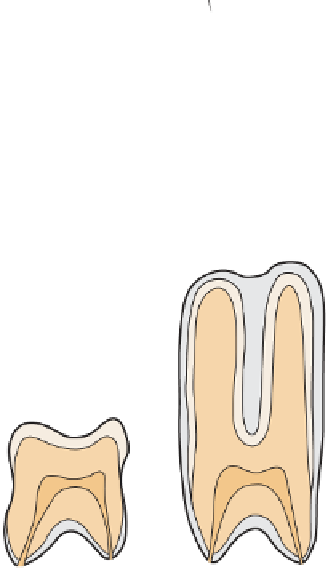Geology Reference
In-Depth Information
◗
Figure 23.23
Evolutionary Trends in Hoofed Mammals
Perissodactyls
Artiodactyls
Ankle
Wrist
Horse
Rhinoceros
Camel
Pig
b
In many hoofed mammals, long, slender limbs evolved as bones
between the wrist and toes, and the ankle and toes, became longer.
a
Perissodactyls have one or three functional toes, whereas
artiodactyls have two or four. Note that in perissodactyls the weight
is borne on the third toe, but artiodactyls walk on toes two and four.
Enamel
Dentine
c
High-crowned, cement-covered chewing teeth (right) evolved in
hoofed mammals that adapted to a diet of grass. Low-crowned teeth
are found in many other mammals, including primates and pigs,
both of which have a varied diet.
Cement
their ancestors, but gave rise to numerous families, several
of which are now extinct (
Horses have a particularly good fossil record, which
shows that present-day
Equus
evolved from a tiny Eocene an-
cestor (
Figure 23.24). Small four-toed
camels, for instance, appeared early in this diversifi cation and
were common in North America well into the Pleistocene. In
fact, most of their evolution took place on this continent and
only during the Pliocene did they migrate to South America
and Asia where they now exist.
Certainly, the most common existing artiodactyls are
the
bovids,
represented by cattle, goats, bison, and many spe-
cies of antelope. They fi rst appeared in the Miocene fossil
record and continued to diversify throughout the rest of
the Cenozoic. Most bovid evolution took place in Europe
and northern Asia, but these creatures have since migrated
to southern Asia and Africa where they are most common
today.
The perissodactyls—horses, rhinoceroses, tapirs—and
the extinct titanotheres and chalicotheres are united by sev-
eral shared characteristics (see Figure 18.18). Furthermore,
the fossil record shows that they all evolved from a com-
mon ancestor during the Eocene. Their diversity increased
through the Oligocene, but since then, they have declined
markedly and now constitute less than 10% of the world's
hoofed mammal fauna.
◗
Figure 23.25). Most of their evolution took place in
North America. Fossils show several trends, such as increased
size, lengthening of the limbs, and development of high-
crowned chewing teeth, as horses became speedy grazing
animals (Table 23.1). There was, however, another branch
of horses leading to three-toed browsers that became extinct
during the Pleistocene.
◗
Other Mammals—Carnivores, Elephants, and Whales
During the Paleocene, the
miacids,
small carnivorous mam-
mals with short heavy limbs, made their appearance. These
small creatures were ancestors to all later members of the order
Carnivora, which includes, among others, today's dogs, cats,
hyenas, bears, weasels, and seals. All have well-developed canine
teeth for slashing and tearing, and most also developed a pair
of large shearing teeth (
Figure 23.26a). Some of the better-
known fossil carnivores are the saber-toothed cats, or what are
more commonly called saber-toothed tigers (Figure 23.26b).
Elephants (order Proboscidea), the largest land mammals,
evolved from pig-sized ancestors during the Eocene. And by
Oligocene time, they clearly showed the trend toward large
◗




















































Search WWH ::

Custom Search